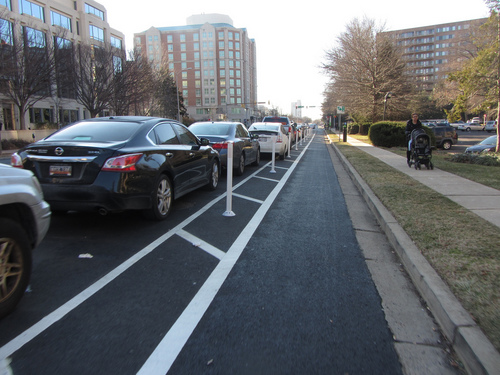Safer Maryland bikeways get the green light
Thanks to new guidelines, curb-protected or buffered bike lanes will be allowed on Maryland state roads. This change could ultimately make many roads much safer.

Eads Street in Arlington. This will now be permitted on Maryland’s state highways. Photo by the author.
The Maryland State Highway Administration (SHA) released new policy and engineering guidelines in January. They will allow more innovative and protective bike infrastructure in many rapidly urbanizing suburbs such as College Park, where Route 1 is supposed to get a bike lane but needs one that’s safe alongside high-speed traffic.
Changes add space between cars and bikes and make intersections safer
Bike lane designs can now include extra buffering, such as striped and cross-hatched lane markings, to separate bike and car traffic. And while the new guidelines don’t mention the use of flexposts, which engineers and planners around the country often use for extra visibility and “soft protection” for buffered bike lanes, SHA also doesn’t forbid them. And that’s encouraging.
The new regulations will also allow bike lanes raised up between the height of the main roadway and the curb. Raised lanes further increase the separation of people biking from motor vehicle traffic, and help prevent people from driving or parking their cars in spaces that are for people on bikes.
The guidelines also introduce designs for “bike boxes,” which allow cyclists to wait in a visible location at the head of a line of traffic and make it easier and safer to turn. Other places have been using bike boxes for several years, but they haven’t been permissible on Maryland state roads until now.
All of these new approaches to protecting and separating bike lanes from traffic on busy or high-speed roads will be better than the bike lane designs SHA is currently using. For example, the photo below shows a newly-painted bike lane on Greenbelt Road near the Capital Beltway. Would you feel safe riding your bike in that lane? Would you want children or elderly people riding in it?
This is a great step, but SHA’s work is far from finished
While we applaud SHA’s new guidelines, there are still some key problems with their overall bike lane design approach.
First, building bike lanes to fit the new guidelines is still not mandatory, making the guidelines somewhat limited in scope. Even though SHA policy now allows buffered and protected bike lanes, engineers are still allowed to build narrow unprotected lanes alongside high-speed or high-traffic state roads. Protected and buffered bike lanes should be the standard, not just an option, especially where separated sidepaths are not feasible.
Noticeably absent are designs for facilities such as two-way protected bikeways, protected intersection designs, and creative ways of accommodating transit adjacent to bike lanes— since people often ride bikes between buses and the curb, it’s crucial that transit riders have easy places to cross bike lanes to get to their buses or transit vehicles.
Protected bikeways are important because while SHA rules do require new roads to include bike lanes, the typical painted bike lanes are simply too narrow for the kinds of high-speed roads where they often appear. These roads frequently have lower speed limits than the speeds people really drive, meaning that a bike lane designed for a 30-mph street would be inadequate where people are really usually traveling 40, 45, or 50.
Finally, the new guidelines are incomplete in that they don’t include illustrations and criteria for additional bike lane and intersection designs, which are very common in other urban and semi-urban areas. Navigating intersections can be tricky for cyclists— they’re where the majority of collisions happen— so it’s very important to get their design right.
For people who want to ride their bikes safely in Maryland, the new state guidelines are a strong pedal-stroke in the right direction. We hope this is the beginning many positive changes coming from SHA to incorporate and implement state-of-the-art designs that will increase the safety of people riding bikes, especially for the more densely populated and urbanizing parts of the state.

